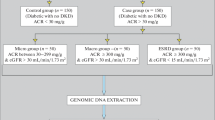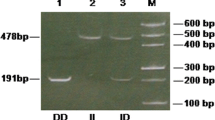Abstract
There are controversial results related to the contribution of insertion (I)/deletion (D) polymorphism of the angiotensin I-converting enzyme (ACE) in the development of diabetic nephropathy. To assess the distribution of this polymorphism in diabetic patients with and without nephropathy we studied 140 unrelated type 2 diabetic patients from the Kermanshah Province of Iran with ethnic background of Kurds including 68 patients with macroalbuminuria and 72 normoalbuinuric diabetic patients as controls. Genotyping was done by polymerase chain reaction (PCR). The frequency of D allele in nephropathic and normoalbuminuric patients were 69.1 and 58.3%, respectively (P = 0.061). In individuals with DD genotype the risk of macroalbuminuria increased 2.87-fold (P = 0.057). Significant lower level of serum ACE activity was found in the normoalbuminuric (59.76 IU/l) compared to macroalbuminuric (97.43 IU/l) patients. The serum ACE activity was significantly higher in macroalbuminuric patients with ID (105.7 IU/l) and ID + DD (100.7 IU/l) genotypes compared to normoalbuminuric patients with the same genotypes (63.5 and 64.2 IU/l, respectively). Treatment with captopril significantly (P = 0.045) reduced the serum ACE activity in normoalbuminuric patients with DD genotype compared to macroalbuminuric patients with the same genotype (33.6 vs. 73.8 IU/l). However, the greatest benefit effect of losartan therapy on ACE activity was observed only in macroalbuminuric patients with DD genotype compared to that in normoalbuminuric patients (61.0 vs. 109.0 IU/l, P = 0.06). Our study suggests the importance of ethnic origin in the development of diabetic nephropathy and demonstrates different responses to therapy according to genotype and stage of diabetes.
Similar content being viewed by others
References
Vaisi-Raygani A, Rahimi Z, Nomani H et al (2007) The presence of apolipoprotein ε4 and ε2 alleles augments the risk of coronary artery disease in type 2 diabetic patients. Clin Biochem 40:1150–1156
Hadjadj S, Fumeron F, Roussel R et al (2008) Prognostic value of the insertion/deletion polymorphism of the ACE gene in type 2 diabetic subjects. Diabetes Care 31:1847–1852
Jacobsen PK (2005) Preventing end stage renal disease in diabetic patients: genetic aspect (part I). J Renin Angiotensin Aldosterone Syst 6:1–14
Arfa I, Abid A, Nouira S et al (2008) Lack of association between the angiotensin-converting enzyme gene (I/D) polymorphism and diabetic nephropathy in Tunisian type 2 diabetic patients. J Renin Angiotensin Aldosterone Syst 9:32–36
Ruggenenti P, Bettinaglio P, Pinares F et al (2008) Angiotensin converting enzyme insertion/deletion polymorphism and renoprotection in diabetic and nondiabetic nephropathies. Clin J Am Soc Nephrol 3:1511–1525
Movva S, Alluri RV, Komandur S et al (2007) Relationship of angiotensin-converting enzyme gene polymorphism with nephropathy associated with type 2 diabetes mellitus in Asian Indians. J Diabetes Complications 21:237–241
Azimi-Nezhad M, Ghayour-Mobarhan M, Parizadeh MR et al (2008) Prevalence of type 2 diabetes mellitus in Iran and its relationship with gender, urbanisation, education, marital status and occupation. Singapore Med J 49:571–576
Rahimi Z, Merat A, Gerard N et al (2006) Implications of the genetic epidemiology of globin haplotypes linked to the sickle gene in Southern Iran. Hum Biol 78:719–731
Nikzamir A, Nakhjavani M, Esteghamati A et al (2008) Correlates of ACE activity in macroalbuminuric type 2 diabetic patients treated with chronic ACE inhibition. Nephrol Dial Transplant 23:1274–1277
Nikzamir A, Esteghamati A, Feghhi M et al (2009) The insertion/deletion polymorphism of the angiotensin-converting enzyme gene is associated with progression, but not development, of albuminuria in Iranian patients with type 2 diabetes. J Renin Angiotensin Aldosterone Syst 10:109–114
American Diabetes Association (2004) Nephropathy in diabetes. Diabetes Care 27:S79–S83
WHO Study Group Report of a WHO consultation: Part 1 (1999) Diagnosis and classification of diabetes mellitus. World Health Organization, Geneva
Old JM, Higgs DR (1983) Gene analysis. In: Weatherall DJ (ed) Methods in hemotology. Vol 6. The thalassemias. Livingstone, UK, pp 74–101
Nakhjavani M, Esfahnian F, Jahanshahi A et al (2007) The relationship between the insertion/deletion polymorphism of the ACE gene and hypertension in Iranian patients with type 2 diabetes. Nephrol Dial Transplant 22:2549–2553
Maguire GA, Price CP (1985) A continuous monitoring spectrophotometric method for the measurement of angiotensin-converting enzyme in human serum. Ann Clin Biochem 22:204–210
Kumar A, Mohindru K, Sehajpal PK (2005) Angiotensin-I converting enzyme polymorphism and diabetic nephropathy in North India. In J Hum Genet 5:279–283
Tang FY, Liu FY, Xie XW (2008) Association of angiotensin converting enzyme and endothelial nitric oxide synthase gene polymorphisms with vascular disease in ESRD patients in a Chinese population. Mol Cell Biochem 319:33–39
Ng DPK, Tai BC, Koh D et al (2005) Angiotensin-I converting enzyme insertion/deletion polymorphism and its association with diabetic nephropathy: a meta-analysis of studies reported between 1994 and 2004 and comprising 14727 subjects. Diabetologica 14:1008–1016
Eleni S, Dimitrios K, Vaya P et al (2008) Angiotensin-I converting enzyme gene and I/D polymorphism distribution in the Greek population and a comparison with other European populations. J Genetics 87:91–93
Zhou JB, Yang JK, Lu JK et al (2010) Angiotensin-converting gene polymorphism is associated with type 2 diabetes: a meta-analysis. Mol Biol Rep 37:67–73
Parving HH, de Zeeuw D, Cooper ME et al (2008) ACE gene polymorphism and losartan treatment in type 2 diabetic patients with nephropathy. J Am Soc Nephrol 19:771–779
Ha SK, Yong Lee S, Su Park H et al (2000) ACE DD genotype is more susceptible than ACE II and ID genotypes to the antiproteinuric effect of ACE inhibitors in patients with proteinuric non-insulin-dependent diabetes mellitus. Nephrol Dial Transplant 15:1617–1623
So WY, Ma RC, Ozaki R et al (2006) Angiotensin-converting enzyme (ACE) inhibition in type 2 diabetic patients: interaction with ACE insertion/deletion polymorphism. Kidney Int 69:1438–1443
Kalaitzidis R, Bakris GL (2009) Effects of angiotensin II receptor blockers on diabetic nephropathy. J Hypertension 27(Suppl 5):S15–S21
Vaisi-Raygani A, Rahimi Z, Tavilani H, Pourmotaabed A (2010) Butyrylcholinesterase K variant and the APOE-epsilon4 allele work in synergy to increase the risk of coronary artery disease especially in diabetic patients. Mol Biol Rep 37:2083–2091
Zoppini G, Targher G, Chonchol M et al (2009) Higher HDL cholesterol levels are associated with a lower incidence of chronic kidney disease in patients with type 2 diabetes. Nutr Metab Cardiovas 19:580–586
Acknowledgment
This work was financially supported by a grant from Vice Chancellor for Research of Kermanshah University of Medical Sciences, Kermanshah, Iran.
Author information
Authors and Affiliations
Corresponding author
Rights and permissions
About this article
Cite this article
Felehgari, V., Rahimi, Z., Mozafari, H. et al. ACE gene polymorphism and serum ACE activity in Iranians type II diabetic patients with macroalbuminuria. Mol Cell Biochem 346, 23–30 (2011). https://doi.org/10.1007/s11010-010-0587-2
Received:
Accepted:
Published:
Issue Date:
DOI: https://doi.org/10.1007/s11010-010-0587-2




